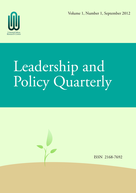


Volume 11 Issues 1-4 (2022-12-31)
Volume 10 Issues 1-4 (2021-12-31)
Volume 9 Issues 1-3 (2020-09-30)
Volume 8 Issues 3&4 (2019-12-31)
Volume 7 Issues 1&2 (2018-06-30)
Volume 6 Issues 3&4 (2017-12-31)
Volume 6 Issues 1&2 (2017-06-30)
Volume 5 Issues 3&4 (2016-12-31)
Volume 5 Issues 1&2 (2016-06-30)
Volume 4 Issues 3&4 (2015-12-31)
The world is becoming one interconnected place where events do not happen in isolation, and organizations are faced with an evolving context. In this paper, the term quicksilver is used to describe an environment that is fluid, uncertain, complex and sometimes ambiguous. Such an environment demands that leader's demonstrate agility of the mind and actions. In a quicksilver environment the spoils go to the creative and not to the compliant; leaders who maximize their conceptual agility and their organization's adaptability and flexibility; and organizations that focus on metrics, learning, self management and adaptability. In quicksilver environments, leaders must be able to work in a strategic way. Working in a strategic way means understanding the signals coming from one's environment and being able to develop and deliver an actionable strategy. A strategic leader framework is used to capture the new skill set required to work in a strategic way. The author proposes a study of strategic leadership for school reforms worldwide, by making use of the leadership framework introduced.
Utilizing multiple leadership frameworks developed by Bolman and Deal (1991) and Cheng (2003), the study explored the cognitive frameworks used by an expert elementary principal in Taiwan for problem-solving during four critical events. This paper also extended the idea of multiple leadership frameworks by identifying its contingence of usage. Participatory observations, interviews, and documents were used. The paper found out that the expert principal applied multiple cognitive frameworks to solve school problems, however, he primarily employed symbolic, human resource, educational, and structural frameworks rather than the political framework. Besides, he used different frameworks to solve different problems. The usage of leadership frameworks by the principal is dependent upon the problems at hand. Specifically, he primarily employed human resource, symbolic and educational frameworks for appointments and resignations; structural frameworks for school conflicts and crises; educational, symbolic, and human resource frameworks for education issues; and multiple cognitive frameworks for school administration issues.
In sports and games competitions, research has identified various judgment biases that have influences on referees and judges. It is reasonable to expect that biases occur in the realm of sports and games if one assumes that judgment of athletic performances follows the basic principles of social experiences. The accuracy of decisions in athletic competitions is critical because biased judgments can have a tremendous impact on the outcomes of an event. Given the significant financial and personal resources that go into the preparation of the athletes it is paramount to have a consistent and reliable scoring system. This review article discusses the judgment biases in sports and games competitions. Implications for practice are discussed.